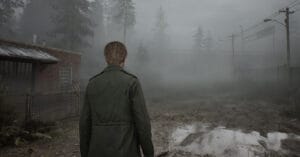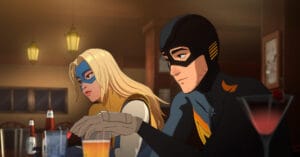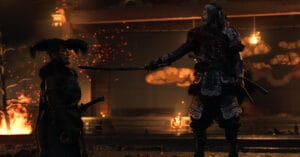My experience with Death Stranding is a curious one. When I first played the original game, I thought it was fine. I found the gameplay therapeutic, but the story didn’t really click with me. And if you’ve followed this blog for a while, you’ll know I’m mostly drawn to story-driven games.
Since I take my ‘work’ as a blogger VERY seriously, I decided to replay Death Stranding in the lead-up to Death Stranding 2: On the Beach. This time, I understood the story a lot better, and once I started the sequel, everything suddenly fell into place.
That wasn’t just because Kojima Productions made a ton of quality-of-life improvements to an already solid system, but also because I found myself playing it differently.
Don’t worry: this review contains no spoilers (except for the first game). And honestly, even if I tried, it would be hard to explain all the twists and developments anyway.
Here’s My Attempt to Summarize the Story Setup Without Spoilers: Wish Me Luck

Death Stranding 2: On the Beach takes place 11 months after the events of the first game. The world is still dealing with a supernatural phenomenon known as the Death Stranding, which caused the realms of the living and the dead to collide.
The dead now manifest as invisible entities called BTs. When a living person comes into contact with one, it triggers a deadly event known as a voidout. People with a condition called DOOMS, like our protagonist Sam Porter Bridges (Norman Reedus), are the exception. They can sense these entities, and in some cases, even see them.
In the first game, we reconnected America and witnessed Sam forming a deep bond with his BB, Lou. In part two, you’re sent out on another mission, though I won’t spoil the reason why. What I can tell you is that this time, it takes place outside of America, and that shift in setting is a welcome one.
The Story Still Demands Your Full Attention, but Thankfully Several Safety Nets Have Been Added This Time Around

Things become even more complex and especially stranger, which is exactly what you would expect from the wild and creative mind of Hideo Kojima. Fortunately, Death Stranding 2 includes a thorough recap of the first game, presented as a series of slides you can scroll through at your own pace.
One of the most welcome additions is the Corpus. I’ve said it before, but every game with deep lore should include something like Active Time Lore, as Final Fantasy XVI handled so well.
In Death Stranding 2, whenever unusual or unfamiliar terms appear during cutscenes, you can hold a button to immediately get background information on that topic. Beyond that, the Corpus is always accessible and filled with detailed entries about everything in the Death Stranding universe, from terminology to its characters.
Whenever something new happens in the story, the relevant Corpus entry is automatically updated. It is a great reference point if you ever lose track of developments.
“Many games overlap in various ways, but the experience Death Stranding offers is truly one of a kind.”
But the Corpus is not the only tool that helps keep you grounded. Enter your new companion: Dollman. It almost feels as though he was created solely to help players follow along. He is always by your side, quite literally, and while I appreciated his presence, there were moments when it felt like someone at Kojima Productions said to Hideo Kojima, “Look, we love your imagination and all the twists and turns, but we need someone who can guide the player a bit more.”
I can easily imagine how that conversation went. The same people probably came up with the grounded idea for the Corpus, while Kojima responded with, “WHAT IF WE INCLUDE A TALKING PUPPET WHO ACCOMPANIES SAM ON HIS JOURNEY?!” In the end, both ideas were added. Probably a compromise.
To his credit, Dollman does help clarify things. He neatly recaps events as they unfold. Sometimes this is helpful, but other times it feels a bit redundant, as he occasionally states the obvious.
Besides summarizing story moments, he also reminds you when it is time to shower and even compliments you afterward. No one benefits more from Sam’s fresh scent than the companion literally attached to him, especially after all those long treks.
It Never Ceases to Amaze Me How Simply Walking Can Feel So Therapeutic

In real life, I’m not much of a hiker. I occasionally get roped into walks by people who do like it, but I mostly look forward to the part where we collapse onto a café terrace. But in Death Stranding, I absolutely love it. I could play the entire game without needing combat. Just walking is enough.
It just feels good. Of course, it helps that the environments are stunning: gentle rivers, towering peaks, dense forests, or sprawling deserts. Everything looks gorgeous and is a joy to walk through. Even better is that moment when, after covering miles of ground, you finally spot your destination on the horizon and slowly draw closer.
And when, right then, one of those beautiful and distinctive Death Stranding tracks fades in, it becomes almost magical. It’s something I can only try to describe, but you really have to experience it for yourself. Many games overlap in various ways, but the experience Death Stranding offers is truly one of a kind.
Preparation Is Half the Battle
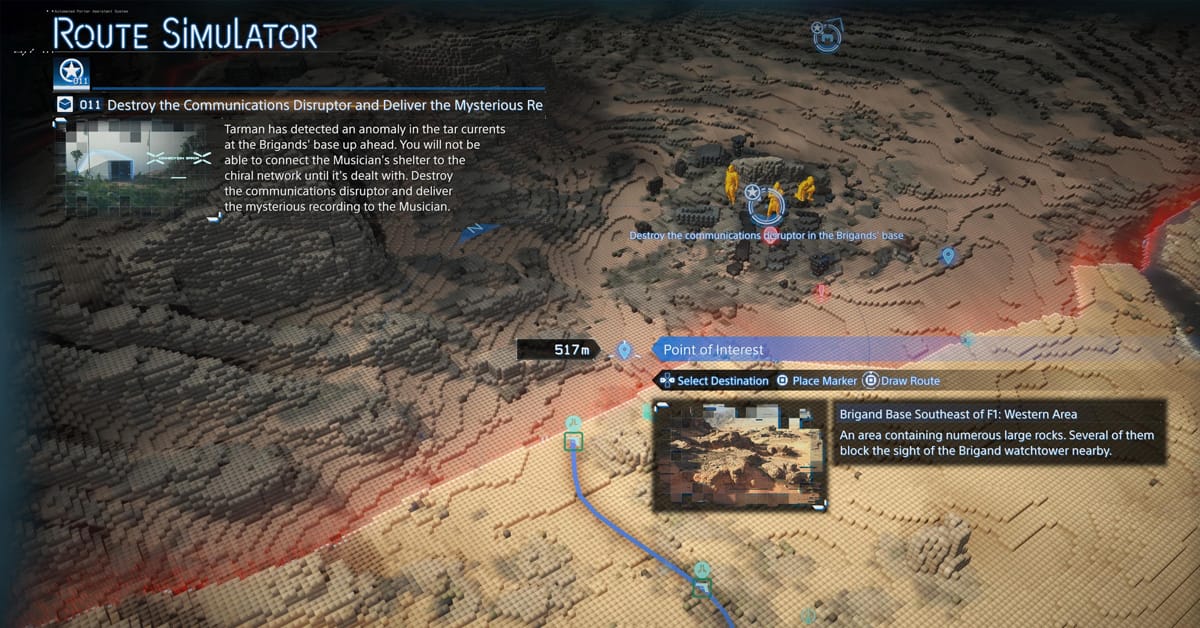
To make sure your journey goes as planned, you can simulate your route ahead of time. Thanks to a detailed map that you can tilt and rotate, you can spot potential obstacles in advance. It helps you weigh different options, such as taking the shortest but steepest path, or choosing a longer route with less climbing.
The map also marks points of interest and danger with icons. Especially tricky spots come with a warning, allowing you to prepare accordingly. You can even see where BT activity has been detected or where enemy Brigands might be lurking. It’s up to you whether to plan your route around them or face the threat head-on.
Depending on your decision, you can prepare in different ways. Taking the steep route? Bring ladders and climbing anchors. Expecting BTs? Pack some Blood Grenades to deal with them effectively. Passing through enemy territory? Make sure you’re well-armed and protected. If you’re going for a stealthy approach, bring suppressed weapons and quiet shoes.
Both Avoiding and Engaging in Combat Are Appealing Options in Death Stranding 2

In the first game, combat felt clunky, and I usually avoided it. In Death Stranding 2, I still prefer walking peacefully toward my goal, but when enemies cross my path, I no longer shy away.
Clearing enemy camps is rewarding in itself, as there’s plenty of loot to collect, like construction materials you can use to restore roads or monorails. On top of that, gunfights are no longer a chore.
Slow-motion effects play a big role. For example, when an enemy spots you, time briefly slows down. This gives you a moment to line up a satisfying headshot before they can raise the alarm. The same effect kicks in every time you take out an enemy. If you aim well, you can chain together multiple headshots, or use the slowdown to dodge bullets at just the right moment.
Choosing to go on the offensive also feels more exciting thanks to the huge variety of tools at your disposal. This game gives you so many ways to shape your approach to combat, and every time I unlocked a new weapon or gadget, I couldn’t wait to try it out on those poor Brigands.
Gaming Is All About Rewards, and Death Stranding 2 Absolutely Nails It

At its core, gaming is driven by rewards. Whether it’s narrative payoffs, XP, or unlocking new skills, we as players want our efforts to feel worthwhile. And let’s be honest, we deserve that.
Death Stranding 2 rewards you so thoroughly for your efforts that you might start to feel the onset of RSI just from clicking through all the reward screens.
Every time you earn a new star from a prepper, you can expect something in return: new tools or weapons, increased bandwidth (allowing you to build more structures like bridges and zip-lines), APAS enhancements (which grant extra abilities), extra APAS memory (so you can activate more of those abilities), or new skills for Sam himself. Think better balance on rough terrain, or a higher maximum carry weight. It’s all in there.
This generous reward system also makes it incredibly motivating to go beyond the main quest. I found myself far more driven than in the first game to max out my prepper connections, happily taking on loads of optional orders just to see what I’d unlock next.
Death Stranding 2 Doesn’t Just Tell a Beautiful Story, It Also Gives You All the Tools to Create Your Own

The music player, one of these many rewards, plays a key role in this. Zoning out, turning on that incredible soundtrack, and heading off to deliver packages always gave me a sense of satisfaction. Every time I reached a destination, I checked the available orders to decide which direction to head next, and which deliveries I could stack along the way.
I also used each stop to pick up any available materials, which I then used to repair roads and monorails. Again, the game never forces you to do this, but I got a real sense of fulfillment from helping rebuild the world. It felt good knowing that future deliveries would be easier thanks to a road I had put in place.
In short, during much of my playthrough, I was crafting my own story and setting my own goals. And it felt fantastic. Hideo Kojima doesn’t just present a carefully directed, beautifully written, and masterfully acted narrative. He also gives you the freedom to carve out your own path. It’s the best of both worlds.
Improvements in Almost Every Area Make Death Stranding 2 Impossible to Put Down
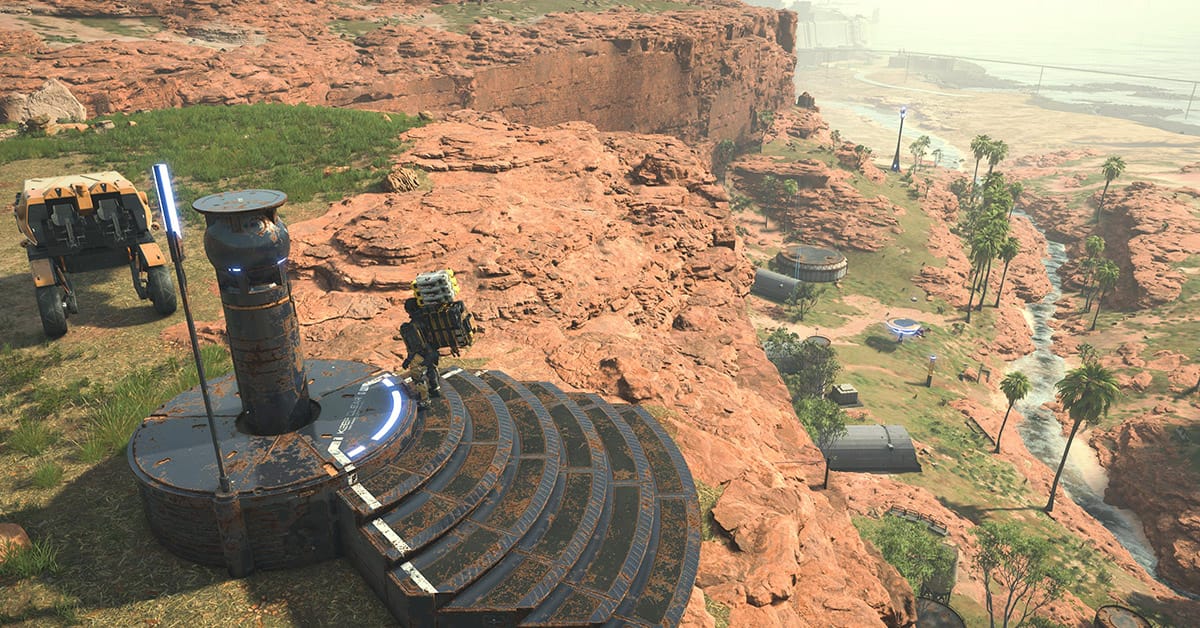
Death Stranding 2 doesn’t reinvent the wheel. At its core, it’s the same “skeleton” as its predecessor, but this time there’s so much more flesh on the bones. Every game mechanic and structure worked well in DS1, but here they simply work even better.
Take the watchtowers, for example. Now, they don’t just allow you to scout enemy camps; they also display heatmaps showing where other players were spotted during their infiltrations. Or the postboxes, which you can now use not only to store and retrieve materials but also to hide in, and even claim materials from.
Another relief is that you can now bring back excess materials when repairing infrastructure. In the first game, any surplus materials were lost, but this time they return neatly to your inventory.
“During the intro, I honestly wasn’t sure if I was watching live action or game renders (it was the latter).“
The addition of a day/night cycle is also very welcome. Visually, Death Stranding 2: On the Beach is breathtaking. During the intro, I honestly wasn’t sure if I was watching live action or game renders (it was the latter). The day/night cycle not only makes the world feel more alive but also adds even more visual spectacle.
Vehicles have also been improved, especially the Pickup Off-Roader. It handles much better and gets stuck less often between obstacles. You can equip it with a large number of batteries, a sticky gun that collects scattered packages for you without having to get out, or heavy weapons that automatically attack enemies.
I probably spent 90% of my time in my trusty off-roader. On one hand, I really enjoyed this, but on the other hand, it leads me to the nitpicky part of this review.
The Off-Roader and One of Its Key Upgrades Are Just Too Efficient

Once I unlocked the off-roader, I rarely went on foot anymore. The vehicle is simply too efficient to choose walking instead. And honestly, I found that a bit disappointing, since hiking is one of my favorite parts of the game.
You might be thinking: who stopped you from just leaving the off-roader behind? All I can say is that my laziness won out. Sure, I could have always chosen to make my deliveries on foot. But when someone hands you an easier way to do things, who am I to say no?
Still, I would have liked to see the off-roader toned down a bit. In my opinion, the game would have been even better if it had slightly less battery power available. In my nearly 100-hour playthrough, I only once had to sweat because my beloved vehicle was running low on battery and close to breaking down.
“In my nearly 100-hour playthrough, I only once had to sweat because my beloved vehicle was running low on battery and close to breaking down.“
But nine times out of ten, there was a generator nearby, kindly placed by one of the other players sharing the world with me (if you’re playing online). Otherwise, you can set one up yourself, if you’ve brought a PCC along.
At one point, I ventured into the mountains, and to my initial dismay, I saw that my off-roader couldn’t reach some of the peaks. During this phase, I walked more on foot again, and it felt like old times. It was just Sam and his legs against the harsh elements; exactly what Death Stranding is all about, in my opinion.
Not long after, I unlocked new tires for the off-roader that let me conquer the mountains without any trouble. From that moment on, my hiking days were mostly over. I settled my ass back comfortably in the seat and hardly got out until the credits rolled.
Speaking of Harsh Elements: Were They Really That Harsh?
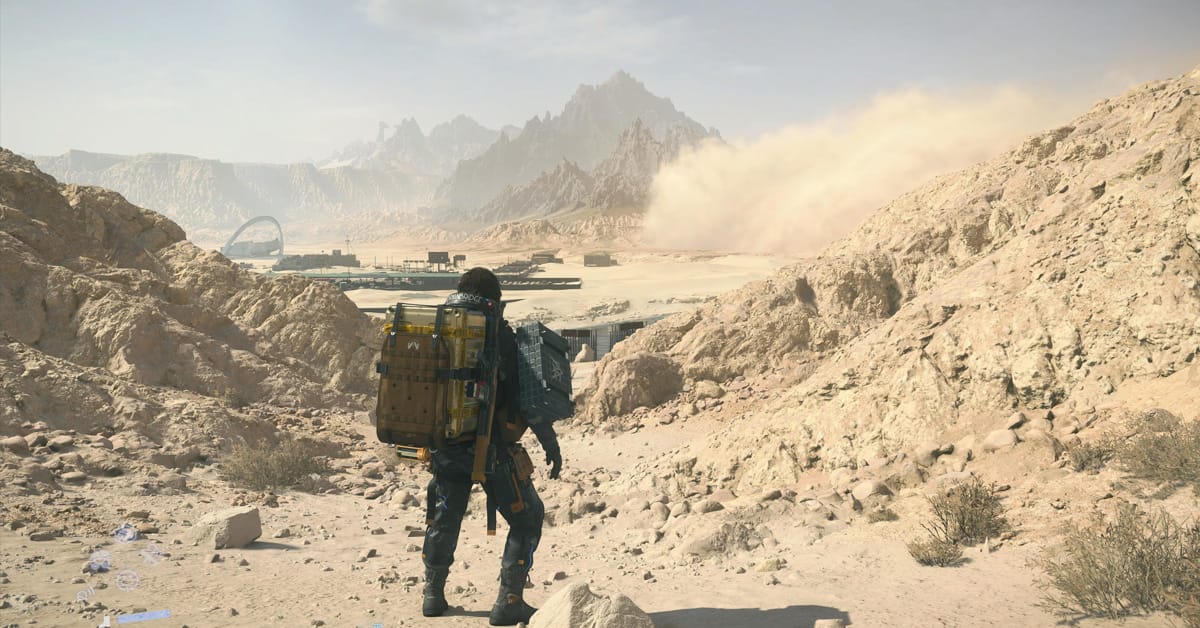
Alright, one more small point of criticism. One of the new features in this game is a dynamic weather system that brings new threats, such as sandstorms and earthquakes.
You get introduced to these pretty early on, and I had high expectations. The first time a storm hit me, it was noticeable. It was harder to steer Sam in the right direction, and visually it was difficult to see where to navigate.
But looking back on my adventure, I actually encountered very few real issues because of them. Sure, during earthquakes Sam wobbles on his legs, but after a few seconds you can calmly continue right where you left off. I didn’t have to struggle at all to stay on my feet.
The storms mostly just limited visibility. With your Odradek scanner, though, you can easily see through the haze. For me, these natural phenomena were mostly visually impressive. It was striking to see a sandstorm rolling toward you from afar, and then being swallowed up by it.
Still, I can’t shake the feeling that more could have been done with them gameplay-wise.
Some Loose Scraps

- The new chiral creatures might look cute, but they can be a real pain.
- Form Strand Contracts with your friends. It’s great to stumble upon signs or structures from them in your own world.
- Mike Flanagan (director of the fantastic The Haunting of Hill House) and his wife Kate Siegel (who starred in the same series) make an appearance as preppers, along with musician Woodkid, and many other familiar faces.
- Getting shot by Brigands or dragged under by BTs is annoying, but nothing’s more frustrating than having your favorite track cut off just because you’ve left the chiral network.
- I haven’t even mentioned Troy Baker yet. Once again, he steals the show as Higgs. Another brilliantly unhinged performance.
- Pay attention to what Dollman says, and try playing a fitting song for him in your private room.
Conclusion

Death Stranding 2 is exactly how a sequel should be: it preserves the identity and everything that made the original great, while adding subtle quality-of-life improvements across the board that keep everything fresh and make the experience even better.
The story tackles heavy themes with elegance, yet there’s still plenty of room for the quirky little touches that make the game so unique. One moment I found myself smiling at the screen, and the next, I could feel tears welling up.
Add to that a fantastic soundtrack, with several tracks that have already found a spot on my Spotify playlists, and you have a game that overwhelms you on every front.
I would have liked to be a bit more forced to travel on foot, since in my opinion the off-roader is a little too efficient. But that’s a minor flaw, one you can easily fix yourself by simply mustering the willpower to limit your off-roader usage.


